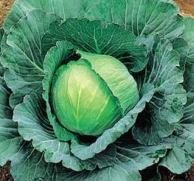Cabbage
"The time has come," as the walrus said in Alice and the Looking "Of shoes, and ships, and sealing-wax; of Cabbages, and kings."
Added Jun 17, 2010
| 9,361 Reads
The Cabbage, which is fabled to have sprung from the tears of the Spartan lawgiver, Lycurgus, began as the Colewort, and was for six hundred years, according to Pliny and Cato, the only internal remedy used by the Romans. The Ionians had such a veneration for Cabbages that they swore by them, just as the Egyptians did by the onion. With ourselves, the wild Cabbage, growing on our English sea cliffs, is the true Collet, or Colewort, from which have sprung all our varieties of Cabbage—cauliflower, greens, broccoli, etc. No vegetables were grown for the table in England before the time of Henry the Eighth. In the thirteenth century it was the custom to salt vegetables because they were so scarce; and in the sixteenth century a Cabbage from Holland was deemed a choice present. The whole tribe of Cabbages is named botanically Brassicaceoe— apo tou brassein—because they heat, or ferment. By natural order they are cruciferous plants; and all contain much nitrogen, or vegetable albumen, with a considerable quantity of sulphur; hence they tend strongly to putrefaction, and when decomposed their odour is very offensive. Being cut into pieces, and pressed close in a tub with aromatic herbs and salt, so as to undergo an acescent fermentation (which is [75] arrested at that stage), Cabbages form the German Saurkraut, which is strongly recommended against scurvy. The white Cabbage is most putrescible; the red most emollient and pectoral. The juice of the red cabbage made into syrup, without any condiments, is useful in chronic coughs, and in bronchial asthma. The leaves of the common white Cabbage, when gently bruised and applied to a blistered surface, will promote a free discharge, as also when laid next the skin in dropsy of the ankles. All the Coleworts are called "Crambe," from krambos, dry, because they dispel drunkenness. "There is," says an old author, "a natural enmitie between the Colewort and the vine, which is such that the vine, if growing near unto it, withereth and perisheth; yea, if wine be poured into the Colewort while it is boiling, it will not be any more boiled, and the colour thereof will be quite altered." The generic term Colewort is derived from caulis, a stalk, and wourte, as applied to all kinds of herbs that "do serve for the potte." "Good worts," exclaimed Falstaff, catching at Evans' faulty pronunciation of words,—"good worts,"—"good cabbages." An Irish cure for sore throat is to tie Cabbage leaves round it; and the same remedy is applied in England with hot Cabbage leaves for a swollen face. In the Island of Jersey coarse Cabbages are grown abundantly on patches of roadside ground, and in corners of fields, the stalks of which attain the height of eight, ten, or more feet, and are used for making walking sticks or cannes en tiges de choux. These are in great demand on the island, and are largely exported. It may be that a specially tall cabbage of this sort gave rise to the Fairy tale of "Jack and the bean stalk." The word Cabbage bears reference to caba (caput), a head, as signifying a Colewort which forms a round head. Kohl rabi, from caulo-rapum, cabbage turnip, is a name given to the Brassica oleracea. In 1595 the sum of twenty shillings was paid for six Cabbages and a few carrots, at the port of Hull, by the purveyor to the Clifford family. The red Cabbage is thought in France to be highly anti-scorbutic; and a syrup is made from it with this purpose in view. The juice of white Cabbage leaves will cure warts. The Brassica oleracea is one of the plants used in Count Mattaei's vaunted nostrum, "anti-scrofuloso." This, the sea Cabbage, with its pale clusters of handsome yellow flowers, is very ornamental to our cliffs. Its leaves, which are conspicuously purple, have a bitter taste when uncooked, but become palatable for boiling if first repeatedly washed; and they are sold at Dover as a market vegetable. These should be boiled in two waters, of which the first will be made laxative, and the second, or thicker decoction, astringent, which fact was known to Hippocrates, who said "jus caulis solvit cujus substantia stringit." Sir Anthony Ashley brought the Cabbage into English cultivation. It is said a Cabbage is sculptured at his feet on his monument in Wimbourne Minster, Dorset. He imported the Cabbage (Cale) from Cadiz (Cales), where he held a command, and grew rich by seizing other men's possessions, notably by appropriating some jewels entrusted to his care by a lady. Hence he is said to have got more by Cales (Cadiz) than by Cale (Cabbage); and this is, perhaps, the origin of our term "to cabbage." Among tailors, this phrase "to cabbage" is a cant saying which means to filch the cloth when cutting out for a customer. Arbuthnot writes "Your tailor, instead of shreds, cabbages whole yards of cloth." Perhaps the word comes from the French cabasser, to put into a basket. From the seed of the wild Cabbage (Rape, or Navew) rape-seed oil is extracted, and the residue is called rape-cake, or oil-cake. Some years ago it was customary to bake bread-rolls wrapped in Cabbage leaves, for imparting what was considered an agreeable flavour. John Evelyn said: "In general, Cabbages are thought to allay fumes, and to prevent intoxication; but some will have them noxious to the sight." After all it must be confessed the Cabbage is greatly to be accused for lying undigested in the stomach, and for provoking eructations; which makes one wonder at the veneration the ancients had for it, calling the tribe divine, and swearing per brassicam, which was for six hundred years held by the Romans a panacea: though "Dis crambee thanatos"—"Death by twice Cabbage"—was a Greek proverb. Gerard says the Greeks called the Cabbage Amethustos, "not only because it driveth away drunkennesse; but also for that it is like in colour to the pretious stone called the amethyst." The Cabbage was Pompey's best beloved dish. To make a winter salad it is customary in America to choose a firm white Cabbage, and to shred it very fine, serving it with a dressing of plain oil and vinegar. This goes by the name of "slaw," which has a Dutch origin. The free presence of hydrogen and sulphur causes a very strong and unpleasant smell to pervade the house during the cooking of Cabbages. Nevertheless, this sulphur is a very salutary constituent of the vegetable, most useful in scurvy and scrofula. Partridge and Cabbage suit the patrician table; bacon and Cabbage [78] better please the taste and the requirements of the proletarian. The nitrogen of this and other cruciferous plants serves to make them emit offensive stinks when they lie out of doors and rot. For the purulent scrofulous ophthalmic inflammation of infants, by cleansing the eyes thoroughly every half-hour with warm water, and then packing the sockets each time with fresh Cabbage leaves cleaned and bruised to a soft pulp, the flow of matter will be increased for a few days, but a cure will be soon effected. Pliny commended the juice of the raw Cabbage with a little honey for sore and inflamed eyes which were moist and weeping, but not for those which were dry and dull. In Kent and Sussex, when a Cabbage is cut and the stalk left in the ground to produce "greens" for the table, a cottager will carve an x on the top flat surface of the upright stalk, and thus protect it against mischievous garden sprites and demons. Some half a century ago medical apprentices were taught the art of blood-letting by practising with a lancet on the prominent veins of a Cabbage leaf. Carlyle said "of all plants the Cabbage grows fastest to completion." His parable of the oak and the Cabbage conveys the lesson that those things which are most richly endowed when they come to perfection, are the slowest in their production and development.
Added Jun 17, 2010
| 9,361 Reads
Share The Magic ...
The GoE MONEY!!! Course - A Course In Real MONEY MAGIC!
|





















